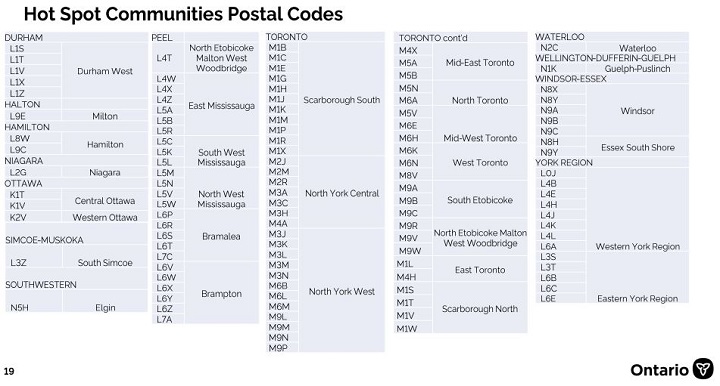Ontario officials said those who are aged 18 and older in high-risk hot spot areas — defined by select postal codes — are now eligible for a COVID-19 vaccine as part of mobile or pop-up clinics.

“Host” organizations defined as faith-based organizations, community settings, and employer-hosted workplace clinics will promote mobile and pop-up clinics within “high-risk” hotspot areas and schedule appointments.
“Eligible individuals can visit their local public health unit website to get details on upcoming clinics in their community and how to book an appointment,” officials said in the documents.
One example provided in recently updated vaccine plan documents released Tuesday is a pop-up vaccination clinic through BAPS Shri Swaminarayan Mandir.
The pop-up clinic, offered by Hindu community leaders, is in a hotspot in North Etobicoke (Toronto’s northwest end). Ministry of Health partnered with BAPS charity, William Osler Health System and Toronto Public Health to operate the clinic.
The clinic is expected to run for three weeks to vaccinate about 15,000 people. Those eligible are 18 and older in postal codes: M9R, M9V, M9W, L4T and L6S.
Appointments for the pop-up clinic begin Tuesday for vaccinations to start the following day on April 14. Residents can book through William Osler for vaccinations at BAPS Swaminarayan Complex.
Ontario looking at employer-hosted vaccine clinics

Get weekly health news
Ontario said it is also working with local public health units for the feasibility of onsite workplace vaccination clinics in hot spot communities.
Workplaces will be selected based on being in a hot spot, employees who cannot work from home, had a previous outbreak or are at risk of outbreaks, and workers who primarily reside in hot spots.
Officials said the employer will take on the responsibility for setting up, operating and funding the onsite vaccination clinic. The employer would also be responsible for vaccinating not only the workers but also residents in the community.
“Onsite workplace vaccination clinics in hot-spot communities will be activated on a rolling basis depending on local operational needs, supply of vaccines and readiness to deploy as determined jointly by the local health unit and business.”

Some education workers eligible to get COVID-19 vaccine
Education workers who work with students with special needs across the province are eligible to book a vaccination.
Also eligible, are Toronto or Peel Region education workers in select hot spot communities in who live or work in-person at both elementary and secondary schools. Education workers include teachers, educators, custodial staff, administrative staff and school bus drivers.
For those who work in a hot spot neighbourhood, but don’t live in it, they will need a letter from their school board confirming employment to be used as proof of identity.
Bookings began Monday and can be made through the Provincial Vaccine Booking Line. Local public health units not using the provincial system will make arrangements with school boards directly to provide booking information, officials said. Vaccinations will be made primarily at mass immunization clinics.
On Tuesday, the provincial government reported administering 3,310,157 total COVID-19 vaccine doses. That marks an increase of 95,692 vaccines in the last day. There are 335,262 people fully vaccinated with two doses.
The province said it has the capacity to administer up to 150,000 doses per day “if supply would allow” but is only administering just under 100,000 daily.
Pfizer-BioNTech, Moderna and Oxford-AstraZeneca are the vaccines currently being used in Ontario. The first two are being administered in all settings except for pharmacies which is solely administering the AstraZeneca vaccine.

Currently, Ontario indicated the following age groups and the percentage of the population who have received their first dose:
- People aged 80 and older: 88 per cent
- People aged 75 to 79: 81 per cent
- People aged 70 to 74: 62 per cent
- People aged 65 to 69: 38 per cent
- People aged 60 to 64: 35 per cent
- People aged 55 to 59: 20 per cent
- People aged 50 to 54: 14 per cent











Comments